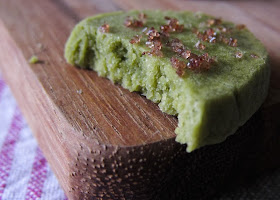 |
| A cool lavender green tea plum wine, served on the rocks. |
We're closing in on the end of another year and the beginning of a new one, yet again, and this means an alcoholic beverage recipe to mark the occasion, of course! In previous years, I've made ginger-lime-cider shandy, raspberry cucumber cocktail slushy, and spiked lemon-jasmine-banana smoothie.
This year, it's a very light and gentle plum wine cocktail, one that can be served hot or cold, so it doesn't matter whether you're in the Northern or Southern hemisphere - this is a drink for all seasons.
The inspiration for this drink stems from my trips to Japanese restaurants, where I've occasionally seen plum wine and green tea combinations, or ocha-wari, on the menu. For some reason I've never gotten around to ordering it, so I have no idea how my invention compares, but I will certainly treat myself next time I see ocha-wari on a drinks list. In the name of research, you understand.
This is a very flexible recipe, where you should feel free to adjust the amounts to your liking. Would you like tea with a hint of wine, or wine with a hint of tea? It's totally up to you.
 |
| Lavender green tea plum wine cocktail, served warm. |
lavender green tea plum wine cocktail
First step - make the lavender green tea:
1 cup freshly boiled hot water
1 heaped teaspoon dried lavender buds (x2 if using fresh lavender), or a lavender tea bag
1 heaped teaspoon loose leaf green tea, or a green tea bag (a floral or herb infused one is lovely, e.g. jasmine green tea, or pomegranate green tea)
1 teaspoon lemon juice
Pour the boiling-hot water over lavender, and let it steep, covered, for 5 - 7 minutes. Then add in the green tea, and let it all steep together for 2 - 3 minutes. Strain to remove the buds and leaves. Add lemon juice. Use immediately for a warm cocktail, otherwise let it cool down completely, or chill in the fridge, for a cool cocktail. I would say that this will make up to 4 cocktails, at most, so multiply the recipe if you're planning on plentiful drinks.
Final step - make the lavender green tea plum wine cocktail:
lavender green tea
plum wine
ice cubes (optional)
sake (optional)
For a warm cocktail, combine freshly brewed hot tea, plum wine, and also, optionally, a splash or more of sake.
For a cool cocktail, combine chilled tea, plum wine, a few ice cubes, and also, optionally, a splash or more of sake.
I used a simple ratio of 1 part tea and 1 part wine for a fairly balanced flavour profile - about 1/4 cup of each, to create a small serving. You may use that as a guide, or find your own way!
P.S. I just thought of something. A bit of lychee syrup, or a fresh lychee garnish, would be an amazing addition! I've got to try that next time.
 |
| Drink up! |














































